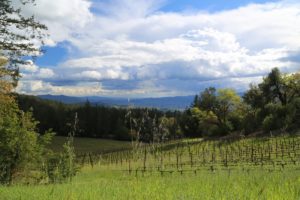 Napa Valley American Viticultural Area (AVA) encompasses a rather small geographical area, produces only 4% of California’s entire wine production and is one of the premium wine growing regions in North America. The earliest vineyards date back to 1836 and the oldest winery is from 1861. The valley itself is only 48 kilometers long and several kilometers wide. However there are a wide range of micro-climates, temperatures, elevation and soil types within this small region. The southern part of the valley is close to the cooling influences of the San Pablo Bay (fog and wind) and dictates the types of varieties grown here – commonly Chardonnay and Pinot Noir. However the north part of the valley is much warmer during the growing season and varieties grown here are red – including Cabernet Sauvignon and Merlot.
Napa Valley American Viticultural Area (AVA) encompasses a rather small geographical area, produces only 4% of California’s entire wine production and is one of the premium wine growing regions in North America. The earliest vineyards date back to 1836 and the oldest winery is from 1861. The valley itself is only 48 kilometers long and several kilometers wide. However there are a wide range of micro-climates, temperatures, elevation and soil types within this small region. The southern part of the valley is close to the cooling influences of the San Pablo Bay (fog and wind) and dictates the types of varieties grown here – commonly Chardonnay and Pinot Noir. However the north part of the valley is much warmer during the growing season and varieties grown here are red – including Cabernet Sauvignon and Merlot.
Two primary mountain ranges run the length of the valley – the Vaca range on the eastern side of the valley and the Mayacamas range on the western side. There is a huge diversity of soil types within this small valley – 33 different soil types exist. Vineyard elevations range from next to sea level to about 731 meters. This small wine region is world famous for the quality of wines it produces and is visited by more than 4.5 million people each year. It is sometimes rare to have premium restaurants in a rural region, but the Napa Valley is also well known for its top restaurants, in 2011 boasting boasting 14 Michelin stars, of which two restaurants have three stars each.
The entire AVA is home to approximately some 500 physical bonded wineries and another approximately 600 virtual wineries.
Prominent producers include: Beringer, Robert Mondavi, Caymus, Cakebread, Joseph Phelps, Heitz among others
Appellation website: www.napavintners.com
Napa’s 17 Sub Appellations
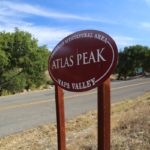 Atlas Peak AVA was founded as an appellation in 1992. This region entirely encompasses hillside terroir ranging in elevation from 230 meters to 810 meters. It takes its name from the mountain peak which reaches 810 meters. Vineyards are fairly spread out due to the geographic nature of the region (steep slopes, various exposures). While this is a “mountain” appellation it is the furthest southern mountain appellation in the Vaca Mountain range in Napa Valley. As a result summers are typically cool, can be windy and generally cooler than the valley floor. This leads to long hang times and even ripening conditions.
Atlas Peak AVA was founded as an appellation in 1992. This region entirely encompasses hillside terroir ranging in elevation from 230 meters to 810 meters. It takes its name from the mountain peak which reaches 810 meters. Vineyards are fairly spread out due to the geographic nature of the region (steep slopes, various exposures). While this is a “mountain” appellation it is the furthest southern mountain appellation in the Vaca Mountain range in Napa Valley. As a result summers are typically cool, can be windy and generally cooler than the valley floor. This leads to long hang times and even ripening conditions.
Soils are among some of the rockiest in all of Napa. Top soil is shallow and many of the vineyards have excellent drainage. There are only two roads that lead into the appellation and both end about 13-16km from the valley floor. Many of the vineyards are west facing.
Prominent producers from this appellation include: Antica, Au Sommet, Bialla, Kongsgaard and vinRoc
Appellation website: www.atlaspeakappellation.com
 Calistoga AVA is one of Napa’s newest appellations having been founded in 2010. This is the northern most appellation in the Napa Valley. Geographically it is located the furthest from the cooling influences of the San Pablo Bay and its region tends to be much warmer during the day than the southern most part of the valley. with that said, some of the diurnal temperature swings are the greatest in this appellation. Its not uncommon to reach 35-37 degrees Celsius during the day in the summer time but then cool down to 10-12 degrees Celsius at night.
Calistoga AVA is one of Napa’s newest appellations having been founded in 2010. This is the northern most appellation in the Napa Valley. Geographically it is located the furthest from the cooling influences of the San Pablo Bay and its region tends to be much warmer during the day than the southern most part of the valley. with that said, some of the diurnal temperature swings are the greatest in this appellation. Its not uncommon to reach 35-37 degrees Celsius during the day in the summer time but then cool down to 10-12 degrees Celsius at night.
This is ideal climate for acid maturity and growing varieties that thrive with these daily temperature fluctuations including Cabernet Sauvignon and a much lesser known variety, Charbono. Calistoga is the only town within this appellation and it is famous for its mud baths and hot springs. The valley floor actually increases in elevation from the San Pablo Bay in the south and by the time you reach the northern most part of this appellation the elevation on the valley floor is around 137 meters.
Prominent producers from this appellation include Chateau Montelena
Appellation website: www.calistogawinegrowers.com
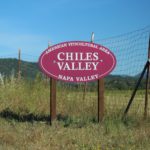 Chiles Valley AVA was founded as an appellation in 1999 is one of Napa’s least known appellations. The appellation spans a long valley located within the Vaca Mountain range, several ridges east of the main Napa Valley floor. Because of both its more northern and eastern location in Napa its climate is less affected by the cooling affects of the Pacific Ocean and the San Pablo Bay. Day time temperatures are often higher than other parts of Napa but night time can cool down and sometimes fog is present. Winter and spring time are often cooler than other parts of Napa. This, along with windy conditions contribute to a long growing season and harvest is usually later than grapes picked on the main valley floor. The main varieties grown here are: Cabernet Sauvignon and Zinfandel. Vineyards tend to be larger here and there are very few wineries within the appellation.
Chiles Valley AVA was founded as an appellation in 1999 is one of Napa’s least known appellations. The appellation spans a long valley located within the Vaca Mountain range, several ridges east of the main Napa Valley floor. Because of both its more northern and eastern location in Napa its climate is less affected by the cooling affects of the Pacific Ocean and the San Pablo Bay. Day time temperatures are often higher than other parts of Napa but night time can cool down and sometimes fog is present. Winter and spring time are often cooler than other parts of Napa. This, along with windy conditions contribute to a long growing season and harvest is usually later than grapes picked on the main valley floor. The main varieties grown here are: Cabernet Sauvignon and Zinfandel. Vineyards tend to be larger here and there are very few wineries within the appellation.
Prominent producers from this appellation include: Brown Estate, Green & Red and Volker Eisle
Appellation website: N/A
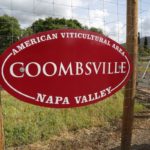 Coombsville – is currently Napa’s newest sub appellation. Initially the region was proposed to be called Tulocay but this was ultimately denied by the TTB, the Alcohol and Tobacco Tax and Trade Bureau. Long time vintner Tom Farella then wrote the proposal to create this sub AVA under the Coombsville name and the region gained it’s AVA status in late 2011.
Coombsville – is currently Napa’s newest sub appellation. Initially the region was proposed to be called Tulocay but this was ultimately denied by the TTB, the Alcohol and Tobacco Tax and Trade Bureau. Long time vintner Tom Farella then wrote the proposal to create this sub AVA under the Coombsville name and the region gained it’s AVA status in late 2011.
The region is generally to the East of the city of Napa. Coombsville is characterized as a moderate to cooler growing climate compared to up valley due to its proximity to the flat region and entry to the nearby San Pablo Bay with its cooling morning and afternoon breezes and often fog influence. The region is generally composed of short rolling hills with a diversity of micro climates even within this small region. It tends to be slightly warmer in vineyards that are located towards the edge of the southern part of the Vaca Mountain Range.
Producers in this AVA tend to be small and family owned – none of the wineries located here are open to the public by walk-in. A small vineyard located in this AVA produces what is typically Napa’s most expensive bottle of wine under the Ghosthorse label. Coombsville originally was thought to be to cold to grow Cabernet Sauvignon. Vineyards have proved this thinking wrong and this variety is certainly sought after by a number of premium producers who are looking to make an elegant wine with good varietal characteristics. Most of the Cabernet Sauvignon in this AVA is grown close to the edges of the hills where the micro climates are slightly warmer than others parts of the region.
Prominent producers from this appellation include Farella, Sciandri, Meteor & Tulocay
Appellation website: www.coombsvillenapa.org
Crystal Springs AVA was founded as a sub appellation in October 2024, 13 years after the previous sub appellation, Coombsville. The filing for this appellation was done by Steve Burgess in December 2020. The appellation encompasses an elevation from 400 feet to 1400 feet and partly borders Howell Mountain appellation. Its topography is generally free of frost. A small appellation, it covers only 230 acres. There are only a handful of wineries within its cozy confines – with growers only outnumbering wineries.
Prominent producers from this appellation include Viader, Burgess (the original winery) and Bremer. And several growers include Hertelendy and Sommnium.
Diamond Mountain AVA was founded as an appellation in 2001. Classic Diamond Mountain land is steep, rugged, brushy, rocky, and east facing. The Mayacamas mountain range in this region, of which the Diamond Mountain appellation is part of, is similar to California’s Sierra Nevada Mountains on a much smaller scale in that the western side of the range has a more gentle elevation gain while the Eastern side drops off rather dramatically. You can experience this on any of the steep narrow roads that climb out of the Napa Valley floor crossing over the Mayacamas. Flat land is at a premium here.
The entire appellation is over 122 meters. Because of its northern location and elevation most of the appellation is above the fog line. The soils are porous and volcanic in nature, often containing black glass (obsidian). The first vines (Cabernet Sauvignon) were planted in this region in the early 1860’s by wine pioneer Jacob Schram (Schramsberg Vineyards). The upper most border of the appellation reaches the ridge line of the Mayacamus mountains and the Sonoma County line but does not cross over.
Top producers from this appellation include: Constant, Diamond Creek Vineyards and Schramsberg
Appellation website: N/A
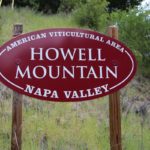 Howell Mountain AVA was founded as an appellation in 1983 – it was the first appellation formed within the Napa valley. Some of the original founding members were Randy Dunn (Dunn Vineyards), Bob Lamborn (Lamborn Vineyards), Robert Brakesman (Summit Lake), grower Mike Beatty and Bill Smith (WH Smith Wines). The appellation is characterized by its elevation which is entirely above 426 meters. As a result the vineyards are above the fog line and see a lot of sunshine throughout the year. Some of the highest vineyards in all of Napa Valley are in this appellation. Howell Mountain is known for its Cabernet Sauvignon and its Zinfandel. The elevation helps insure that evening temperatures are warmer than the valley floor (due to an inversion layer) and daytime temperatures are cooler.
Howell Mountain AVA was founded as an appellation in 1983 – it was the first appellation formed within the Napa valley. Some of the original founding members were Randy Dunn (Dunn Vineyards), Bob Lamborn (Lamborn Vineyards), Robert Brakesman (Summit Lake), grower Mike Beatty and Bill Smith (WH Smith Wines). The appellation is characterized by its elevation which is entirely above 426 meters. As a result the vineyards are above the fog line and see a lot of sunshine throughout the year. Some of the highest vineyards in all of Napa Valley are in this appellation. Howell Mountain is known for its Cabernet Sauvignon and its Zinfandel. The elevation helps insure that evening temperatures are warmer than the valley floor (due to an inversion layer) and daytime temperatures are cooler.
The fresh natural aromas from the Manzanita and pine trees at this elevation are very reminiscent of what you would find in California’s Sierra Nevada foothills at similar elevations. This is the only appellation in Napa with these similar characteristics and on a very clear day from select ridges in the appellation you can actually see part of the Sierra Nevada’s many kilometers in the distance. There are two main soil types in the appellation: a decomposed volcanic ash, called “tufa”, and a prominent red clay that is high in iron.
Top producers from this appellation include: Dunn, Lamborn, Outpost and Robert Foley
Appellation website: www.howellmountain.org
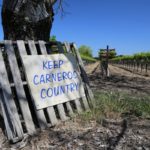 Los Carneros AVA was founded as an appellation in 1983 and is shared with Sonoma County. This is Napa’s premiere region for growing cooler weather varieties. The weather is characterized by foggy and often windy days – with cool nights. It takes longer for grapes to reach maturity and the hang time can be long. Popular varieties grown here are Chardonnay and Pinot Noir.
Los Carneros AVA was founded as an appellation in 1983 and is shared with Sonoma County. This is Napa’s premiere region for growing cooler weather varieties. The weather is characterized by foggy and often windy days – with cool nights. It takes longer for grapes to reach maturity and the hang time can be long. Popular varieties grown here are Chardonnay and Pinot Noir.
The region is characterized by many rolling hills none of which are to far above the sea level. The San Pablo Bay touches the shores of this appellation and it is this body of water that is so instrumental in keeping the weather cool. Carneros means “sheep” in Spanish and before grapes were grown here this was an area that supported a number of sheep farms.
Prominent producers from this appellation include: Domain Carneros, Bouchaine and Truchard
Appellation website: www.carneros.com
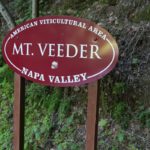 Mt. Veeder AVA was founded as an appellation in 1993. This rugged, very steep and forested appellation contains some of Napa’s most remote wineries. Some of the vineyards in the appellation are among the highest in all of Napa. This is the only Napa mountain appellation that touches the southern most Carneros appellation. As a result the southern part of this appellation experiences cooler moderating influences from the San Pablo Bay. From some of its southern and western most points on a clear day you can see into San Francisco and the Golden Gate Bridge. The growing season is long and the harvest is among the latest in all of the valley.
Mt. Veeder AVA was founded as an appellation in 1993. This rugged, very steep and forested appellation contains some of Napa’s most remote wineries. Some of the vineyards in the appellation are among the highest in all of Napa. This is the only Napa mountain appellation that touches the southern most Carneros appellation. As a result the southern part of this appellation experiences cooler moderating influences from the San Pablo Bay. From some of its southern and western most points on a clear day you can see into San Francisco and the Golden Gate Bridge. The growing season is long and the harvest is among the latest in all of the valley.
The soils for the appellation are unique in Napa – it is the only appellation that contains soils from an ancient seabed that were pushed up as the mountains formed. While some areas in the Napa Valley experience wide diurnal temperature fluctuations – most of Mt. Veeder does not. Being above the fog line the early sun warms the region but due to its proximity to the bay and ocean, the late afternoons are generally moderate.
Mountain tops breed some of Napa’s characters and Mt. Veeder is ground central for some of its’ most interesting vintners – recluses, hermits and several wineries accessible only via 4wd. This is a special place and needs to remain so.
Top producers from this appellation include: Hess Collection, Mayacamus
Appellation website: www.mtveederwines.com
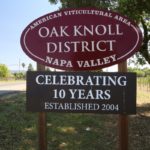 Oak Knoll District was founded as an appellation in 2004. Due to its proximity in the Napa Valley it is a sweet spot between Napa’s warmer up-valley appellations and the cooler Los Carneros region to the south, A number of white varieties do well here, chiefly Chardonnay and of the reds, Merlot is often sourced from this region by premium producers who do not own vineyards here. The appellation is located on the valley floor and has deep alluvial soils. Oak Knoll is one of Napa Valley’s most diverse wine growing appellations as far as the number of varieties grown here.
Oak Knoll District was founded as an appellation in 2004. Due to its proximity in the Napa Valley it is a sweet spot between Napa’s warmer up-valley appellations and the cooler Los Carneros region to the south, A number of white varieties do well here, chiefly Chardonnay and of the reds, Merlot is often sourced from this region by premium producers who do not own vineyards here. The appellation is located on the valley floor and has deep alluvial soils. Oak Knoll is one of Napa Valley’s most diverse wine growing appellations as far as the number of varieties grown here.
While the appellation is fairly small there are a wide variety of micro climates within its borders – lending itself to a wide diversity of varieties. Certain parts of the appellation are better suited for warmer weather varieties while other parts are better for cooler weather varieties.
Top producers from this appellation include: Monticello Vineyards, Robert Biale Vineyards, Trefethen,
Appellation website: www.oakknolldistrictofnapavalley.com
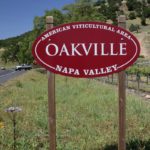 Oakville AVA was founded as an appellation in 1993 and is one of the Napa Valley’s premiere appellations – well-known for its Cabernet Sauvignon. When you examine Oakville closely you realize the diversity in microclimate and soils from the eastern side of the appellation to the western side. As the crow flies, this is approximately only 3.5km apart in length. 5 of Napa’s cult wineries are either in or very close to the Oakville appellation.
Oakville AVA was founded as an appellation in 1993 and is one of the Napa Valley’s premiere appellations – well-known for its Cabernet Sauvignon. When you examine Oakville closely you realize the diversity in microclimate and soils from the eastern side of the appellation to the western side. As the crow flies, this is approximately only 3.5km apart in length. 5 of Napa’s cult wineries are either in or very close to the Oakville appellation.
The western side of Oakville has less sun exposure then the eastern side and the vegetation differs between the two sides. Rather than the open vegetation and drier slopes of the eastern side, the western side is much more forested. The eastern bench land of Oakville was formed by volcanic soil came from the slopes of a long extinct volcano. It is very red in nature – among the most red soil in all of the Napa Valley. The appellation’s annual “Taste of Oakville” is one of the valley’s most prestigious tastings for trade.
Top producers from this appellation include: Dalla Valle, Harlan Estate, Far Niente, Opus One, Robert Mondavi & Silver Oak
Appellation website: www.oakvillewinegrowers.com
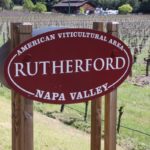 Rutherford AVA was founded as an appellation in 1993 and is centered around the small town of Rutherford. When discussing this appellation its soils usually play a prominent role. This region is characterized by the sometimes “dusty” quality found within its wines. The main soils include gravel, loam and sand with volcanic deposits. Much of this came from alluvial fans which drained from the Vaca mountains. Some of the bench land soils on the eastern side of the appellation are among the most coveted terroir in the valley.
Rutherford AVA was founded as an appellation in 1993 and is centered around the small town of Rutherford. When discussing this appellation its soils usually play a prominent role. This region is characterized by the sometimes “dusty” quality found within its wines. The main soils include gravel, loam and sand with volcanic deposits. Much of this came from alluvial fans which drained from the Vaca mountains. Some of the bench land soils on the eastern side of the appellation are among the most coveted terroir in the valley.
This appellation is located within the widest point of the Napa Valley and as a result annually sees more radiant exposure than the other appellations. Nowhere in the appellation is the elevation above 500 feet although there are certainly quite a few hillside vineyards here.
Top producers from this appellation include: Beaulieu Vineyard, Caymus and Quintessa
Appellation website: www.rutherforddust.org
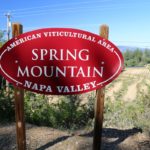 Spring Mountain District AVA was founded as an appellation in 1993. This entirely mountain appellation is known almost exclusively for its red varieties. The appellation boasts rich mountain tannins and expressive wines. Most of the vineyards and wineries are situated along the very windy steep Spring Mountain Road weaves its way up the steep eastern side of the Mayacamas mountains. The appellation was named after a number of small springs in the area. The region is heavily forested and most of the vineyards face east. Due to its elevation it is not uncommon to receive snow in the winter in its upper reaches.
Spring Mountain District AVA was founded as an appellation in 1993. This entirely mountain appellation is known almost exclusively for its red varieties. The appellation boasts rich mountain tannins and expressive wines. Most of the vineyards and wineries are situated along the very windy steep Spring Mountain Road weaves its way up the steep eastern side of the Mayacamas mountains. The appellation was named after a number of small springs in the area. The region is heavily forested and most of the vineyards face east. Due to its elevation it is not uncommon to receive snow in the winter in its upper reaches.
Mornings, especially in the summer tend to warm quicker than the valley floor because the higher elevations of the appellation are typically above the valley fog. The evenings also tend to be warmer then the valley floor due to an inversion layer in which warm air rises up the slopes of the appellation later in the day.
Prominent producers from this appellation include: Cain, Keenan, Marston Family, Pride Mountain, Smith Madrone and Spring Mountain Vineyards
Appellation website: https://springmountaindistrict.org
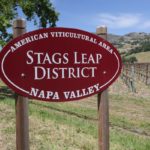 Stags Leap District AVA was founded as an appellation in 1989 and is one of Napa’s most prominent appellations. There are several historical vineyards, one of which, the Fay Vineyard provided fruit for one of the wineries that won the historic Paris Tasting of 1976. Compared to some of Napa’s other appellations, there are very few producers and wineries in the region. Furthermore its not an appellation that has seen an influx of new producers in the last 10-15 years like many of Napa’s appellations. The vineyards in this appellation are also fairly well established.
Stags Leap District AVA was founded as an appellation in 1989 and is one of Napa’s most prominent appellations. There are several historical vineyards, one of which, the Fay Vineyard provided fruit for one of the wineries that won the historic Paris Tasting of 1976. Compared to some of Napa’s other appellations, there are very few producers and wineries in the region. Furthermore its not an appellation that has seen an influx of new producers in the last 10-15 years like many of Napa’s appellations. The vineyards in this appellation are also fairly well established.
Stag’s Leap District was the first viticultural area in the United States to be approved based on the distinctiveness of its soils. There are two main soils that dominate – volcanic which is found along the hillsides and river sediments found at the lower elevations which over the years have formed consistent loams that are somewhat clay-like in nature. The appellation is not large by Napa standards – about 1.5km wide and only 4.5km in length.
Prominent producers from this appellation include: Shafer, Stag’s Leap Wine Cellars and Stags’ Leap Winery
Appellation website: www.stagsleapdistrict.com
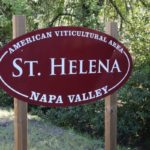 St. Helena AVA was founded as an appellation in 1995. The appellation association’s historical roots date back to 1875 when the association was called the St. Helena Viticultural Club. Some of the benchland on the east facing slopes of the Mayacamas mountains contains some of the most sought after vineyards in the valley.
St. Helena AVA was founded as an appellation in 1995. The appellation association’s historical roots date back to 1875 when the association was called the St. Helena Viticultural Club. Some of the benchland on the east facing slopes of the Mayacamas mountains contains some of the most sought after vineyards in the valley.
A wide range of microclimates exist within the appellation including the narrowest part of the valley which tends to receive a fair amount of wine. This appellation association is one of the strongest associations in the valley with over 60 winery and grower members. Charles Krug, the oldest winery within Napa Valley is within the appellation. The artsy town of St. Helena is the only town within its borders.
Top producers from this appellation include: Beringer, Charles Krug, Duckhorn, Grace Family, Hourglass, Joseph Phelps, Spottswoode and Vineyard 29.
Appellation website: www.appellationsthelena.org
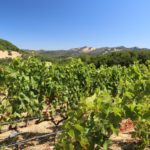 Wild Horse Valley AVA was founded as an appellation in 1988. This is one of only two sub appellations within Napa to also encompass part of a neighboring county (Solano). This is probably the least known of the all of Napa’s appellations. While it seems remote, it is a fairly short drive from the city of Napa. It is a hillside appellation located fairly close to the San Pablo Bay. As a result the appellation experiences the bay’s cooling influences and often windy conditions. The region is ideal for growing Chardonnay and Pinot Noir.
Wild Horse Valley AVA was founded as an appellation in 1988. This is one of only two sub appellations within Napa to also encompass part of a neighboring county (Solano). This is probably the least known of the all of Napa’s appellations. While it seems remote, it is a fairly short drive from the city of Napa. It is a hillside appellation located fairly close to the San Pablo Bay. As a result the appellation experiences the bay’s cooling influences and often windy conditions. The region is ideal for growing Chardonnay and Pinot Noir.
There are two main regions within the appellation. The western side is cooled by the Bay’s influences while experiencing much sun due to its elevation and being generally above the fog line. The eastern part is more protected due to the geographical slopes of the land and is noticeably warmer. However as a whole, this appellation is one of Napa’s coolest growing regions.
Only one winery is located within this appellation, Olivia Brion (on the Solano County side). Along with their own vineyards, only one other winery currently maintains vineyards in this appellation.
Appellation website: N/A
Top producers from this appellation include: Olivia Brion, Kenzo Estate
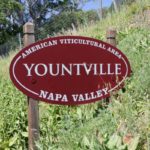 Yountville AVA was founded as an appellation in 1999. This region is characterized by its cooler influences due to its closer proximity the southern end of the valley. While not as south as Carneros, the influence from the fog and wind of the bay is slightly less. This is one of Napa’s sweet spots for growing Sauvignon blanc. The first vineyards in all of the Napa Valley were planted here in 1836 by George Yount.
Yountville AVA was founded as an appellation in 1999. This region is characterized by its cooler influences due to its closer proximity the southern end of the valley. While not as south as Carneros, the influence from the fog and wind of the bay is slightly less. This is one of Napa’s sweet spots for growing Sauvignon blanc. The first vineyards in all of the Napa Valley were planted here in 1836 by George Yount.
The appellation is centered around the town of the same name, Yountville. This is one of Napa’s culinary Mecca’s – within town you have a number of very highly rated restaurants including the 3-star Michelin restaurant French Laundry. The town is small, therefore setup for walking – with restaurants, shops and a number of tasting rooms within a short distance. Note that the town of Yountville did not always have this charm – it was one of the backwater towns in Napa Valley for decades.
Top producers from this appellation include Blankiet, Domain Chandon, Dominus, Gemstone and Kapcsandy
Appellation website: www.yountvillewines.com

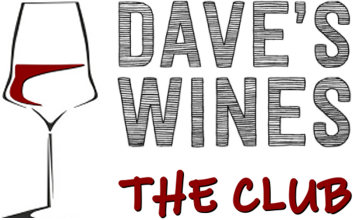

Leave a Reply